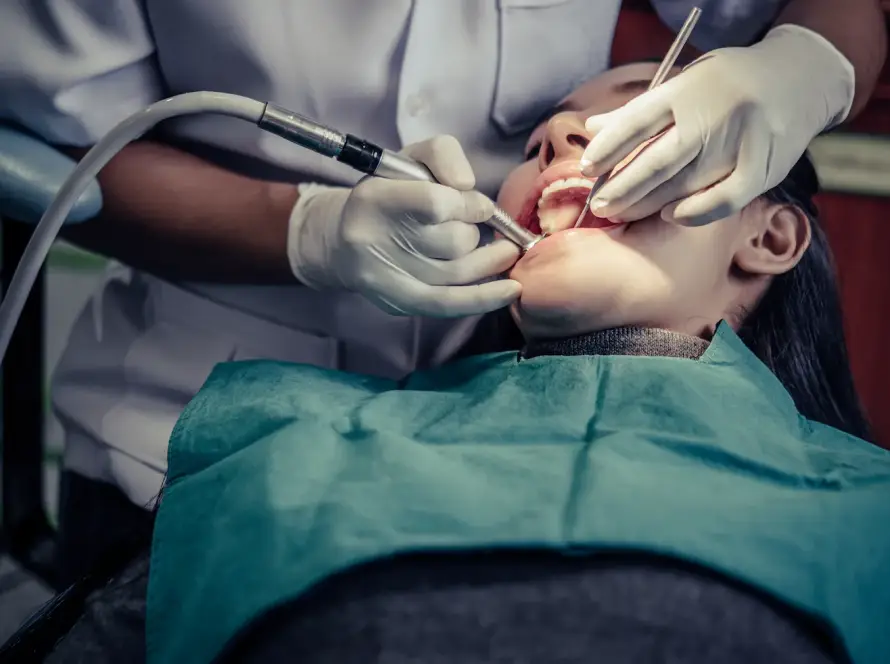![]() Introduction to Dental Anesthesia
Introduction to Dental Anesthesia
Dental anesthesia plays a crucial role in ensuring a comfortable and pain free experience during dental procedures. It involves the use of medication to numb the affected area or induce sedation to minimize pain and anxiety. Dental anesthesia can be administered in various forms, such as local anesthesia, intravenous sedation, nitrous oxide sedation, or general anesthesia.
Local anesthesia, the most common form used in dentistry, involves the injection of an anesthetic agent near the treatment site. It temporarily blocks the nerves, preventing them from transmitting pain signals. This enables the dentist to perform procedures like tooth extractions, fillings, or root canals without causing discomfort to the patient.
Intravenous sedation allows patients to achieve a relaxed and drowsy state during dental procedures. Administered through a vein, this type of anesthesia is commonly used for more complex procedures or patients with severe dental anxiety.
Nitrous oxide, also known as laughing gas, is an inhalation sedative that helps alleviate anxiety and reduce pain perception. It is combined with oxygen and inhaled through a mask during the procedure. Nitrous oxide can be used alone or in combination with local anesthesia for mild to moderate pain management.
General anesthesia is rarely used in dentistry, reserved for complex surgeries or patients with special needs. Under general anesthesia, the patient is in a state of unconsciousness or deep sedation, closely monitored by an anesthesiologist.
Before administering any form of anesthesia, the dentist or anesthesiologist will thoroughly evaluate the patient’s medical history, current health condition, and any specific needs or concerns. This step ensures the safety and effectiveness of the anesthesia chosen for the dental procedure.
In the forthcoming sections, we will further explore the different types of dental anesthesia, their pros and cons, safety measures, and what to expect before, during, and after the administration of anesthesia. It is essential to have a comprehensive understanding of this topic to make informed decisions and alleviate any anxiety associated with dental treatments.
Types of Dental Anesthesia
1. Local Anesthesia:
-
- Local anesthesia is commonly used in dental procedures to numb a specific area of the mouth, providing pain relief during treatment.
- It is administered through an injection near the site of treatment, such as the gums or tooth.
- Local anesthesia blocks the nerve signals responsible for transmitting pain, ensuring a comfortable experience for the patient.
- The effects of local anesthesia typically last for a few hours, allowing the dentist to complete the procedure without discomfort.
2. Nitrous Oxide Sedation:
-
- Nitrous oxide, also known as “laughing gas,” is a mild form of sedation used to help relax patients during dental procedures.
- This type of anesthesia is administered by placing a mask over the patient’s nose, allowing them to inhale a mixture of nitrous oxide and oxygen.
- Nitrous oxide induces feelings of euphoria and relaxation, reducing anxiety and making the experience more pleasant for the patient.
- The effects of nitrous oxide wear off quickly once the mask is removed, allowing patients to drive themselves home afterward.
3. IV Sedation:
-
- Intravenous (IV) sedation involves administering sedative medications through an IV line, inducing a state of deep relaxation or sleep.
- This type of anesthesia is typically used for more complex dental procedures or for patients with severe dental anxiety.
- IV sedation allows the patient to remain conscious but detached from the dental procedure, reducing pain and anxiety significantly.
- It is crucial to have a trained anesthesiologist or dentist administer IV sedation and monitor the patient closely throughout the procedure.
4. General Anesthesia:
-
- General anesthesia is the deepest form of anesthesia, inducing a state of unconsciousness and complete loss of sensation.
- It is typically used for complex procedures, oral surgeries, or when the patient cannot tolerate other forms of anesthesia.
- During general anesthesia, the patient is completely asleep and unaware of the procedure.
- An anesthesiologist closely monitors the patient’s vital signs, ensuring their safety and comfort throughout the entire surgery.
In conclusion, various types of dental anesthesia cater to different patient needs and procedures. Local anesthesia is commonly used to provide pain relief during treatments, while nitrous oxide sedation helps patients relax. IV sedation and general anesthesia are reserved for more complex procedures, offering deep relaxation or unconsciousness. The choice of anesthesia depends on the patient’s comfort level, the type of dental procedure, and the dentist’s recommendation.
The Role of Local Anesthesia in Dentistry
Local anesthesia plays a crucial role in dentistry, ensuring that patients can undergo dental procedures comfortably and with minimal pain. It involves administering an anesthetic agent directly to the area being treated, numbing the nerves and eliminating sensations of pain during the procedure. This allows dentists to perform various dental treatments, including fillings, extractions, root canals, and gum surgeries, without causing unnecessary discomfort to their patients.
Local anesthesia is delivered through several techniques, such as injections, topical applications, or a combination of both. The choice of technique depends on the type and location of the dental procedure, as well as the patient’s specific needs and preferences.
Benefits of local anesthesia in dentistry are numerous. By numbing the treatment area, it ensures that patients experience minimal pain and discomfort during procedures. This also enables dentists to work with precision and accuracy, as patients remain still and cooperative.
Another advantage is that local anesthesia reduces anxiety and fear associated with dental treatments. It helps patients feel more at ease, promoting a positive dental experience and improving overall patient satisfaction. The use of local anesthesia can also be beneficial for patients with dental phobias or those with a low pain threshold.
Local anesthesia also aids in controlling bleeding during dental procedures, as it constricts blood vessels, minimizing the risk of excessive bleeding and facilitating a clear view of the treatment area. Additionally, it can help in reducing post operative swelling and discomfort, enabling patients to recover more comfortably.
Overall, local anesthesia is an essential tool in dentistry that ensures patient comfort and allows dentists to carry out various treatments effectively. With its ability to minimize pain, reduce anxiety, and facilitate optimal treatment outcomes, local anesthesia plays a crucial role in delivering quality dental care.
Understanding General Anesthesia in Dentistry
General anesthesia is a deep state of unconsciousness induced by the administration of medications during dental procedures. It is used in cases where the patient needs to be completely unaware and unresponsive to pain throughout the procedure.
1. Indications for General Anesthesia
-
- When the dental procedure is complex, lengthy, or requires significant surgery.
- If the patient experiences extreme dental anxiety or fear, making it difficult to perform the procedure under local anesthesia alone.
- For patients with special needs or medical conditions that may require additional support and control during dental treatment.
2. Administration
-
- General anesthesia is typically administered through intravenous (IV) injection or inhalation of gas.
- An anesthesiologist or a qualified dental specialist monitors the patient’s vital signs throughout the procedure to ensure safety.
3. Benefits
-
- Provides complete pain control, ensuring the patient’s comfort during the procedure.
- Allows for more efficient and precise dental work, as the patient is completely still and unresponsive.
- Reduces anxiety and fear associated with dental treatment, promoting better overall oral health.
4. Risks and Side Effects
-
- Allergic reactions to anesthesia medications.
- Changes in heart rate and blood pressure.
- Nausea, vomiting, and dizziness after the procedure.
- Difficulty in waking up from anesthesia or feeling groggy.
5. Recovery and Aftercare
-
- Patients may feel drowsy and experience temporary confusion, so a responsible adult should accompany them home.
- Following the instructions provided by the dental professional regarding post anesthetic care is essential.
- It is common to experience some discomfort in the days following the procedure, which can be managed with prescribed pain medication and ice packs.
Understanding general anesthesia in dentistry is crucial for patients who may be considering it as an option for their dental treatment. By knowing its indications, administration, benefits, and potential risks, patients can make informed decisions and work together with their dental team to ensure a safe and successful experience.
The Process of Administering Dental Anesthesia
Administering dental anesthesia involves a systematic process that ensures patient comfort and safety during dental procedures. The following steps are typically followed when administering dental anesthesia:
- Patient assessment: Before administering anesthesia, a thorough assessment of the patient’s medical history, current health, and any previous adverse reactions to anesthesia is conducted. This assessment helps the dentist determine the most appropriate anesthesia technique for the patient.
- Informed consent: The dentist explains the procedure and discusses the potential risks and benefits of anesthesia with the patient. Informed consent is obtained to ensure the patient’s understanding and agreement to proceed.
- Topical anesthesia: Topical anesthesia is often applied to numb the area where the inj
- ection will be given. It helps reduce any discomfort associated with the needle’s insertion.
- Local anesthesia injection: A local anesthetic is then injected near the treatment site to numb the specific area where the dental procedure will be performed. The injection is carefully administered to ensure minimal pain or discomfort. The dosage and type of anesthetic used may vary depending on the procedure and the patient’s needs.
- Monitoring: Throughout the dental procedure, the patient’s vital signs, such as heart rate, blood pressure, and oxygen levels, may be monitored using non invasive devices. Monitoring helps detect any adverse reactions or complications that may arise during the procedure.
- Adjustments and supplemental anesthesia: Depending on the length and complexity of the dental procedure, additional anesthesia may be administered as needed. This helps maintain the patient’s comfort and ensure a pain free experience.
- Recovery and post operative care: After the dental procedure is complete, the patient may be monitored for a short period to ensure a smooth recovery. Any post operative instructions and prescriptions are provided to manage any residual discomfort and optimize healing.
It is important to remember that the administration of dental anesthesia requires the expertise of trained and experienced dental professionals. Dentists and dental anesthesiologists have the necessary knowledge and skills to ensure the safe and effective use of anesthesia during dental procedures.
Potential Risks and Side Effects of Dental Anesthesia
When undergoing dental anesthesia, there are potential risks and side effects that patients need to be aware of. While these occurrences are rare, it is important to understand the possible complications to make an informed decision.

- Allergic reactions: Some individuals may have an allergic reaction to the anesthesia medications used during dental procedures. Symptoms can include hives, swelling, difficulty breathing, and in severe cases, anaphylaxis. Dentists are trained to identify and manage these reactions promptly.
- Nerve damage: In rare cases, dental anesthesia may cause temporary or permanent nerve damage. This can result in altered sensation, numbness, or tingling in the lips, tongue, or cheeks. Dentists take precautions to minimize the risk of nerve injury during treatment.
- Pain or bruising at the injection site: After receiving dental anesthesia, patients may experience temporary discomfort, pain, or bruising at the injection site. These side effects typically resolve on their own within a few days.
- Psychological effects: Some individuals may experience anxiety, restlessness, or other psychological effects after receiving dental anesthesia. Dentists strive to create a calm and relaxing environment to minimize these side effects.
- Systemic complications: Rarely, anesthesia medications can lead to systemic complications such as cardiovascular problems, respiratory depression, or allergic reactions. However, dentists are trained to monitor patients closely during procedures and take appropriate measures to prevent and manage any complications.
It is crucial for patients to discuss any preexisting medical conditions, allergies, or concerns with their dentist prior to receiving dental anesthesia. This will help ensure that the appropriate anesthesia technique and medications are used, minimizing the risks and maximizing patient safety.
Remember, the risks and side effects associated with dental anesthesia are relatively low, and dentists are well prepared to handle any untoward events that may arise. By working closely with your dentist and following their instructions, you can have a safe and comfortable dental experience.
Benefits of Dental Anesthesia in Dentistry
Dental anesthesia plays a crucial role in modern dentistry, providing numerous benefits for both patients and dental professionals. Here are the key advantages of utilizing dental anesthesia:
- Increased patient comfort: Dental procedures can often be uncomfortable or painful. Anesthesia allows patients to undergo treatment without feeling any pain or significant discomfort, enhancing their overall experience at the dentist’s office.
- Reduced anxiety and fear: Many individuals experience anxiety or fear when visiting the dentist, making it challenging to receive necessary dental care. Dental anesthesia helps alleviate these apprehensions by calming patients and ensuring a stress free environment during procedures.
- Improved treatment accuracy: When patients are relaxed and pain free, dentists can perform procedures with better precision and efficiency. Dental anesthesia allows for better access to difficult to reach areas or delicate procedures, resulting in improved treatment outcomes.
- Time saving benefits: By administering anesthesia, dentists can often complete multiple procedures in a single appointment. This streamlined approach saves patients time and reduces the need for multiple visits, making dental care more convenient and efficient.
- Enhanced patient safety: Dental anesthesia is administered by trained professionals who closely monitor the patient’s vital signs throughout the procedure. This ensures a safe and controlled environment, minimizing risks and complications during dental treatments.
- Wide range of options: Dentistry offers various anesthesia techniques, including local anesthesia, nitrous oxide (laughing gas), conscious sedation, and general anesthesia. This range of options allows dentists to tailor the anesthesia approach to individual patients’ needs, optimizing their comfort and safety.
- Effective pain management: Dental anesthesia not only eliminates or reduces pain during procedures but also provides post operative pain relief. Patients can recover more comfortably, allowing for a smoother healing process and encouraging adherence to post treatment instructions.
- Improve treatment accessibility: Some individuals, such as children, patients with special needs, or those with severe dental anxiety, may struggle to receive necessary dental care without anesthesia. Dental anesthesia bridges the gap, enabling these individuals to access the dental treatments they require.
Incorporating dental anesthesia into dental practice offers an array of benefits for both patients and dental professionals. By ensuring patient comfort, reducing anxiety, improving treatment accuracy, and enhancing safety, dental anesthesia enhances the overall dental experience and makes oral care more accessible and efficient.
Alternatives to Traditional Dental Anesthesia
- Nitrous Oxide Sedation: Also known as laughing gas, nitrous oxide sedation is a safe and effective alternative to traditional dental anesthesia. It is administered through a mask placed over the patient’s nose, inducing a relaxed and comfortable state. Nitrous oxide sedation works quickly, and its effects wear off rapidly once the gas is turned off.
- Oral Sedation: For patients with mild to moderate anxiety, oral sedation may be an ideal alternative to traditional anesthesia. This method involves taking a prescribed medication before the dental procedure, which helps reduce anxiety and induce relaxation. It is important to note that oral sedation requires proper preparation and monitoring by a trained dental professional.
- Topical Anesthetics: Topical anesthetics, such as gels or sprays, can be applied directly to the area of treatment to numb the surface tissues. While they may not provide complete pain relief for invasive procedures, they can significantly reduce discomfort during less extensive treatments like dental cleanings or the application of sealants.
- Local Anesthetics with Vibration: The use of dental instruments that incorporate vibration, such as the DentalVibe, can help minimize pain during the administration of local anesthesia. The vibrations create a distraction by stimulating the nerve endings, effectively reducing the sensation of pain. This method is particularly beneficial for patients who are sensitive to dental injections.
- Electronic Dental Anesthesia: Electronic dental anesthesia, also known as nerve stimulation or electronic nerve block anesthesia, has gained popularity as a non invasive alternative to traditional anesthesia. It involves using a handheld device that emits mild electrical pulses to the treatment area. These pulses interfere with the pain signals sent to the brain, resulting in a reduced perception of pain.
While these alternatives to traditional dental anesthesia can provide effective pain management, it is essential to consult with your dentist to determine the most suitable option for your specific needs. By discussing your concerns and preferences with your dentist, you can work together to create a comfortable and stress free dental experience.
Special Considerations for Dental Anesthesia in Children
When it comes to dental anesthesia in children, there are a few special considerations that need to be taken into account. Children may have unique dental needs and requirements compared to adults, and it is essential to ensure their safety and comfort during dental procedures.
One crucial aspect is the selection of the anesthesia technique. Pediatric patients often require a different approach to anesthesia, as they may have limited cooperation or may experience anxiety and fear. Dentists may use techniques like conscious sedation or general anesthesia to help children relax and stay still during the procedure.
Dosage is another critical consideration in pediatric dental anesthesia. The dosage of anesthesia drugs administered to children should be carefully calculated based on their age, weight, and medical history. Dentists must follow specific guidelines to ensure the correct dosage is given, minimizing the risk of adverse effects.
Additionally, the monitoring of children during dental anesthesia is of utmost importance. Continuous monitoring of vital signs such as heart rate, blood pressure, and oxygen saturation helps ensure their safety throughout the procedure. This monitoring allows dentists to promptly detect and address any changes or complications that may arise.
Moreover, the selection of appropriate anesthesia equipment for children is vital. Child sized equipment, including masks, endotracheal tubes, and monitoring devices, should be used to ensure proper fit and accuracy during anesthesia administration and monitoring.
Lastly, post anesthesia care in children needs careful attention. Dentists should provide clear instructions to parents or caregivers regarding aftercare, including possible side effects such as nausea or discomfort. Parents should be advised on what to observe and how to manage their child’s pain or any adverse reactions that may occur post procedure.
Overall, dental anesthesia in children requires specific considerations tailored to their unique needs. By carefully evaluating the anesthesia technique, dosage, monitoring, equipment, and post operative care, dental professionals can ensure the safety and well being of young patients during dental procedures.
The Future of Dental Anesthesia
As advancements in technology continue to shape the field of dentistry, the future of dental anesthesia is poised to undergo significant transformations. Innovations are already emerging that aim to improve patient comfort, streamline administration processes, and enhance the safety and effectiveness of anesthesia techniques.
- Patient Centric Approaches: The future of dental anesthesia will prioritize patient comfort and satisfaction. Researchers are exploring alternative anesthetic delivery methods that minimize pain and anxiety experienced during procedures. Techniques such as virtual reality distraction and audiovisual aids are being integrated into the dental environment to create a more relaxed and positive patient experience.
- Minimal and Non Invasive Techniques: The focus is shifting towards developing minimally invasive anesthesia techniques that reduce discomfort and shorten recovery time. Advancements in local anesthesia formulations and drug delivery systems are enhancing precision and efficacy, allowing dentists to administer anesthesia in a targeted manner, minimizing the need for extensive numbing.
- Digital Solutions: Technological advancements are revolutionizing the administration and monitoring of dental anesthesia. Digital tools such as computerized injection devices and electronic anesthetic record keeping systems are being developed to improve the accuracy and efficiency of anesthesia delivery. Additionally, real time physiological monitoring devices can alert dental professionals to any adverse reactions promptly, ensuring patient safety.
- Pharmacological Innovations: Researchers are continuously exploring new pharmaceutical agents and formulations to improve anesthesia outcomes in dentistry. The development of longer lasting, faster acting, and non toxic anesthetics could provide patients with extended pain relief and reduce the need for multiple injections during lengthy procedures.
- Individualized Anesthesia Protocols: The future of dental anesthesia will see an emphasis on personalized approaches. Through the integration of patient specific factors such as age, medical history, and genetic information, dentists will be able to tailor anesthesia protocols to each individual’s needs, optimizing the effectiveness and safety of the anesthesia administered.
As the future unfolds, dental anesthesia will continue to evolve with the aim of providing patients with enhanced comfort, better outcomes, and improved safety. Dentists and researchers alike are dedicated to harnessing the potential of technological advancements and scientific breakthroughs to revolutionize the field of dental anesthesia.
















